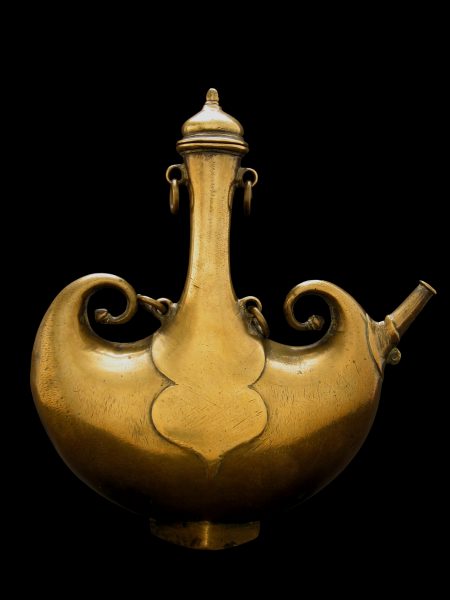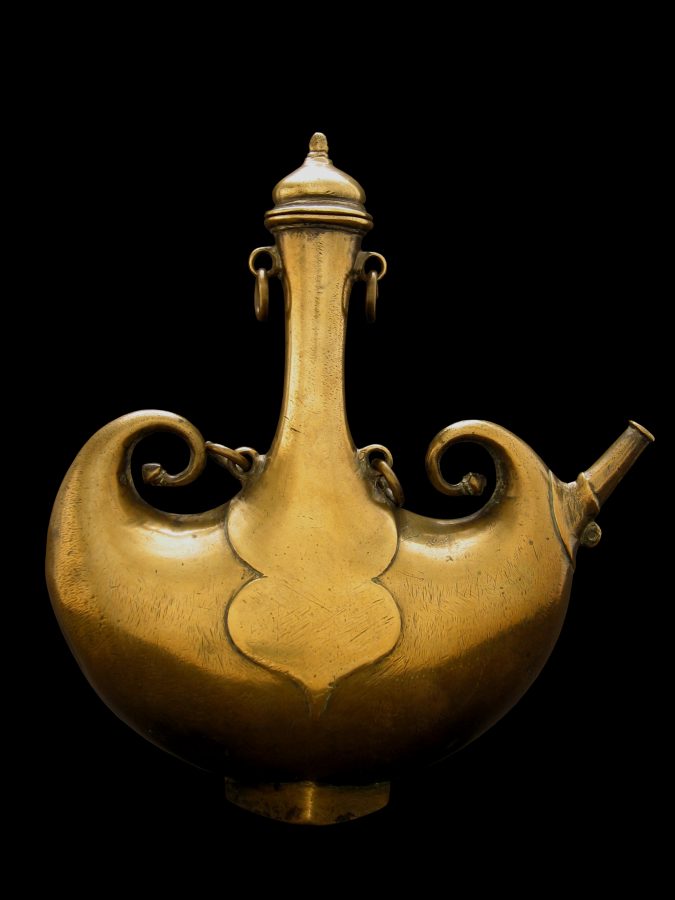This exceptional Indian brass two-handled ewer or pilgrim flask dates to the sixteenth century. The flattened bulbous body terminates at either end in a curled bud finial. A spout projects from one side. The waisted neck has two pairs of attachment loops from which hang brass rings. A further loop is below the spout. The flask stands on a lozenge-shaped base. An original hinged bell-shaped lid terminates in a knop finial; the lid being engraved with a series of concentric circles. The base of the flask is cast to either side with lightly modelled lappet of trefoil form. An early solder repair is evident to the lower part of one side.
Chains or cords would have been fastened to the metal rings and attached to poles so that they could be carried by servants over their shoulders. Early paintings show such vessels in use. Says Zebrowski, “In most of these paintings, the flasks are associated with people of political or spiritual authority, and it is quite possible that this vessel type was thought to be emblematic of high rank.
The design of this flask like the few surviving other examples appears based on a leather or animal skin prototype. Zebrowski (1997) contains a small chapter devoted to such flasks. “This beautiful shape, related to the pilgrim flask of medieval Europe, probably derives from containers made of leather: whole goatskins inflated with water were often depicted in Mughal and Persian paintings.” He adds that the first example to receive attention was one acquired by the British Museum in 1969. It was considered unique at the time but since then, more have come to light. Zebrowski lists (and illustrates) one example each in:
• the Metropolitan Museum of Art, New York;
• the Alvin Bellak Collection, Philadelphia;
• the CL David Collection, Copenhagen;
• the Museum of Fine Arts, Boston;
• the National Museum of India, New Delhi; and
• Five others in private collections
Which, with the British Museum example, brings the total identified by Zebrowski to eleven.
Further examples have since come to light.
Says Piotrovsky and Rogers (2004) in relation to the Khalili example, “Whereas zoomorphic metal vessels in Iran do not appear to have survived the Mongol invasions of the 13th century, in central India they continued to be made up to the 16th century.”
References
Piotrovsky, M.B. and J.M. Rogers (eds), Heaven on Earth: Art from Islamic Lands, Prestel, 2004.
Zebrowski, M., Gold, Silver & Bronze from Mughal India, Alexandria Press, 1997.



